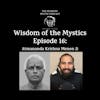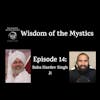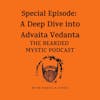Thoughts on the Bhagavad Gita: (Chapter 13: Verses 17 - 20)
Host Rahul N Singh delves into an in-depth analysis of the Bhagavad Gita Chapter 13, Verses 17-20. In this episode of The Bearded Mystic Podcast. He explains the concepts of the field of experience, knowledge of all categories, ultimate reality, and the Brahman being in detail. Rahul integrates various philosophies including Sankhya and Vedantic philosophies and discusses the role of prakriti and individual atmas. He also encourages listeners to support the podcast on Patreon and invites them to free virtual meditation sessions every Saturday at 11:00 AM (EST).
Translation used: The Bhagavad Gita Comes Alive: A Radical Translation by Jeffrey Armstrong
If you enjoyed listening to the 85th episode of the Thoughts on The Bhagavad Gita and want to listen to more episodes like this on the Bhagavad Gita, or on Non-Duality, or the wisdom of the Mystics please follow/subscribe to this Podcast. New episodes are uploaded every Sunday.
Thoughts on the Upanishads, Conversations with the Bearded Mystic, Guided Meditations, and much more only on Patreon, Buzzsprout Subscriptions, Apple Podcast Subscriptions and Supercast.
Patreon: Support The Bearded Mystic Podcast and get ad-free, bonus episodes along with many more benefits:
https://www.patreon.com/thebeardedmysticpodcast
Buzzsprout Subscriptions: Support The Bearded Mystic Podcast and get ad-free, bonus episodes: https://www.buzzsprout.com/1800416/subscribe
Direct & Unfiltered with The Bearded Mystic is a great format to ask The Bearded Mystic (Rahul) whatever question you have in your mind. Submit your question by completing this survey please.
Join The Bearded Mystic Podcast Discussion Group on Whatsapp: https://chat.whatsapp.com/GcCnyrjQwLuEPHBaVA6q9L
Be notified of my weekly virtual meditation session followed by a Q&A Discussion via zoom (Notifications only):
https://chat.whatsapp.com/DcdnuDMeRnW53E0seVp28b
Please rate and write a review for this Podcast: https://www.thebeardedmysticpodcast.com/reviews/new/
You can follow me and contact me on social media:
Website: https://www.thebeardedmysticpodcast.com
TikTok: https://vm.tiktok.com/ZMdk3HPJh/
Instagram: https://www.instagram.com/thebeardedmysticpodcast/
Youtube: https://www.youtube.com/c/TheBeardedMysticPodcast/
Twitter: https://twitter.com/bearded_mystic
Facebook: https://www.facebook.com/The-Bearded-Mystic-Podcast
Rahul N Singh:
Hello and welcome to The Bearded Mystic Podcast and I'm your host Rahul N Singh. Thank you for joining today and taking the time to either watch or listen to this podcast episode. If you are really interested in supporting The Bearded Mystic Podcast, and you've found great benefit in listening or watching these episodes, then please do support this podcast on Patreon where you can get ad free and bonus episodes along with other benefits depending on the tier that you select. Your support means everything, and it really does help the podcast keep running efficiently and smoothly, and also widens the audience that this message can reach to. If you would like to know more about it, the details are in the show notes and video description below. On Saturdays at 11:00 AM Eastern Standard Time there is a free virtual meditation session along with discussion and Q&A. If you're interested in meditating with us as a community, then you can find out the details in the show notes and video description below. Please do like, comment, and subscribe if you're watching this on YouTube and if you're listening to this on your favorite podcast streaming app, then please do give this podcast a five star rating. It helps the podcast get up in the charts and allows the algorithm to bring this podcast to new listeners and also do review the podcast if you can and make sure you do follow or subscribe to keep getting future episodes. So today we're going to be continuing on with my thoughts on the Bhagavad Gita and we'll be continuing with chapter 13. And today we will be looking at verses 17 to 20. And let's get started with verse 17. That great Brahman Being is a singular and undivided reality, even though it appears to be divided and standing inside of all beings. This Being is also known as the Sustainer and support of all beings, as well as the Creator and the one who devours all. So, let's look at the first part of the verse. That great Brahman being is a singular and undivided reality, even though it appears to be divided and standing inside of all beings. First of all, this great Brahman being, this knower of the field, is first singular. There's only one. Yeah, it is without a second. It's, it's not many, it's one. And then it's an undivided reality. It is indivisible. It is not in many parts, neither is it divided into many little Atmas or many little beings or, even into infinite number of atoms. It's not divided in any way. First and foremost, and that's the important thing to understand. So it's a singular and undivided reality. It's indivisible. It's the ultimate reality. There is no second to it. There is no other to it. It's the only reality there is, that is the only thing existing and beyond existence too. So this is literally it, very simply. And this world that we see is the appearance that seems to be divided and seems to have many beings. And let's consider all beings being every single object in this universe, sentient or non sentient. Now, this world that we know, it's a transactional reality. It's exists upon each other, transacting with each other, prakriti transacting with prakriti, and upon investigation, it's unreal, this appearance of many, and when I go into this, we'll look at the rope and the snake example, but let's go into the verse a little. Even though it appears to be divided, so because we see many beings, because we see many objects in existence, we think that this pure consciousness is divided into those many beings. Sri Krishna says this is wrong, it appears to be divided. It's not actually divided, it appears to be divided. And, to make this clear that it appears to be divided the next statement is very important. He says, and standing inside of all beings. It is there within all beings because it's one. So for example, this world that we see that we think is divided into many different parts, into everything having its own reality or existence. If we look at the rope and snake example, this explains it very well. In the twilight night, you're walking down the The road and there's a tree in front of you and you see that there's something dangling on the, on the branch of that tree and this creates a bit of fear in you because you superimpose that there must be a snake there and you're pretty scared, you, you know, you're wondering should I walk past it? What if it's a snake and it bites me? What do I do? You know, what's the best thing for me to do? Well, in today's day and age, we would be like, okay, it's twilight, it's pretty dark, I can't make out what it is, let me take out my mobile phone, my cell phone, and let me put the flashlight on. You put the flashlight on it, you, you know, you stand a good distance, just in case it attacks you when you put the light on it. You look at it, and you find out, it's not a snake, it's actually a rope, but you thought it was a snake, yeah, you saw it dangling, because of the wind it was moving, you were like, this has to be a snake, but when you put the light upon it, you realised, it wasn't a snake, it was just a rope, it's not going to attack you, you can safely walk down the road, likewise, we can actually look at it this way, that Once you know that this world is nothing but Brahman, you can walk in this world without any worries at all. It's like when they say that you transcend the bhavsagar, when you transcend this world appearance, this, this, this ocean of materialism. And that's what it simply means. And that's what we have to understand is, it appears to be different, but really it's one and the same. And... likewise, this Brahman is inside of all beings, and it's one in all beings, it's not separated in all beings, it's one unity in all beings. What you could say, it's like a garland of flowers, or like the mala that I'm wearing, the thread in between the beads is what unites it all, so that awareness is what binds all of the separate beads, right? So the awareness within us is the one that is binding all of us together, yeah? Just like the thread on my mala is holding all the beads together. So there is no other reality, it's a single reality, only one reality. This witness consciousness is standing in all beings. We've established this. It is the vertical aspect of awareness as well as horizontal. So, what I mean by that is, when you rest in awareness, you may feel that awareness is vast and, and it's everywhere. So you think of it as a horizontal thing. So it's spread out here like that. But also, it's, you know, a vertical thing where you feel centered in it too. So you both feel centered and vast. Because it's not only in you. It's also everywhere. It's all pervading., It's in all directions, and that's why you can relate to it. Remaining in awareness of formless awareness is how we find it within. So, when we become aware of that formless awareness within, when we become aware of the observer within, we then find that it's not only within me, that same observer is within everyone. They think they have a separate observer, but it's just that one same observer, that same one Brahman being, that great Brahman being. Then Sri Krishna adds in that verse that this being is also known as the sustainer and support of all beings as well as the creator and the one who devours all. One thing here is that he's talking about is the trinity that we know of, which is Brahma, Vishnu, Mahesh. Brahma being the creator. Vishnu being the sustainer and supporter of all beings, and the one who devours all is Shiv Ji, Maheshwara. So, what he's saying is, this being is the one, you know, you may see it as Vishnu, Brahma, and Shiv Ji, but it's actually just Brahman. It's that one Nirguna Brahman, that's it, that is the one that is the sustainer, that is the one that's supporting all beings, that is the one that is the creator of all beings, and that is the one that will destroy every being, yeah. Or you can even use the one who devours all as Kaal, as Kaal Bhairav, time or Yama devta, the, the deva of death. You can see it in many ways, right? There's not one single way to see it, but basically this Brahman is the Shared Being that sustains all existence. All beings exist because of the Shared Being, has basically imagined us. This whole world is just the imagination of Brahman or you can see it as the imagination of Brahman. But we in this world are literally are just a dream in the Shared Being. That's all we are. Now, the shared being also participates in this dream, just like how, when we're in a dream, we can feel that we are participating in a dream, despite knowing that we are watching ourselves in the dream. So, it's the same thing here, where in the Shared Being or Saguna Brahman, or... Ishvara, basically it is in the dream, as well as knowing it is watching the dream. So that's a unique, that's a unique perspective that Vedanta provides. When we wake up, when we awaken ourselves, when we shine that light, we realize that actually this dream world is nowhere to be seen because there's only this One Reality. So this dream world that I've created, that I think I'm observing and participating in, is actually just... This One Reality. It's Brahman that's also the creator that has manifested this whole existence. It will also ensure the dissolution of existence occurs into itself so it will just basically implode into itself as just as well it expands from itself regardless of the creation, sustenance and destruction of existence this witness consciousness, this Brahman remains untouched and unharmed and remember most importantly this Formless Awareness is what you are. Then Sri Krishna says in verse 18. This sustainer, the ultimate light of all lights is the source of the stars and is always shining beyond the darkness of tamas. It is knowledge, the object that is to be known, the ultimate destination toward which knowledge is leading. As well as the Being who is seated within the hearts of all. Living beings. This sustainer, the Ultimate Light of all Lights, is the source of the stars and is always shining beyond the darkness of tamas. We've kind of talked about the light just in the previous verse, but this Shared Being of Brahman basically is what sustains all of existence, we know this, that's what it's referring to as the sustainer, and it's the ultimate light of all lights. So, for example, when you think of this solar system, the Ultimate Light is this Sun. When the sun sets, what you have is the moon that shines, but remember the light is coming from the sun, and then you see the many stars. But when the sun rises... where do the stars disappear when the only thing that lights up this earth is the sun? Likewise, this Brahman is what lights up all the appearance of the other living beings. So these living beings that we see are illuminated by that one ultimate light of existence, which is Brahman. The other thing to understand is that You can also have it as that all the other lights in existence is all the different types of knowledge that we may find in Vedanta or in the Vedic texts, but the ultimate light is that which points towards Brahman. So Brahm Gyana is the ultimate light. That's another way of viewing this. The wisdom of being aware of formless awareness shines regardless of the tamsik aspect of nature. So even if one is in ignorance, this still shines, this will never disappear at all. This is forever shining even if one is in a cave. We have created that cave of ignorance, of darkness, but outside that light is still shining even though we cannot see it. And this Gyana is the light that takes us out of laziness in the spiritual practice too. We constantly can be lazy and tired and we don't want to do spiritual practice. We don't want to do Namjapa. We don't want to do meditation. We don't want to listen to spiritual thoughts. We don't want to read the scriptures. We don't have enough time now. We are so busy. Doing nonsense stuff. The Gyana takes us out of that because once you have just one, uh, subtle meeting with this Brahman, you will never let go. That is what happens. It's the intoxicant that puts all the other intoxicants to a minimal effect. And so once we hear these holy words, once we read the scriptures, once we do Naam japa, once we be in the awareness of Nirguna brahman, awareness of formless awareness, when we serve others while we're remembering the Lord selflessly, then we no longer feel lazy, that laziness is uprooted from us. Then in the second part of the verse... Sri Krishna says that it is the knowledge, the object that is to be known, the ultimate destination toward which knowledge is leading, as well as the being who is seated within the hearts of all living beings. So first of all, we know that this Brahman is the knowledge itself. Yeah, it's the sacred knowledge that moves us forward, that takes us into evolution, where we can take the next step as human beings in terms of evolution. Not in the sense of we'll gain extra powers or anything, just that insight into remaining as awareness. And it's the object that is to be known. It's the only thing that's worth knowing. It's the only thing that remains with us beyond mind and body. So, it's the only thing worth entertaining, it's the only thing worth getting to know and realizing. And knowledge is the ultimate destination, this Gyana is the ultimate destination itself. This Brahman is Gyana itself. remember that it's the freedom which is the ultimate destination is where this knowledge is going to lead us to, so once we take this Brahm Gyana, once we acclimatise to it, once we implement it in our lives, once we have the Anubhava of Brahman, then what happens is, we go towards what it's leading towards, which is, freedom, which is liberation. The advanced understanding of this would be that even Gyana is mukti itself, gyan is liberation itself, knowledge of Brahman is liberation itself, it's freedom itself, and this knowledge of Brahman is manifested as a Shared Being, so it's seated within the hearts of all living beings, because it is the Shared Being in all, it is that Light within all, it's the heart of all, within all. So when we're in the awareness of Formless Awareness, we are automatically in peace because we know that it's, it's the same one in all. And this verse, specifically this part shows us the oneness with all living beings, that there's no separation here. It's that same one that is seated in all the hearts. For example, when we say namaste, when we say namaskar, when what we're doing is we're honouring that same divinity that's within us in all other people. So we're not looking at the name and form, we're looking at that formless aspect. verse 19. Thus I've explained the field of experience, the Gyana which is the knowledge of all categories, and that which is ultimately to be known. Therefore, one who hears this becomes mad bhakta, which is deeply and fully devoted to Me, and achieves a state of realized understanding. In this way, one who is devoted to Me, achieves a direct understanding of My true divine nature. So let's break this verse up. Thus, I have briefly explained the field of experience, the knowledge of all categories, and that which is ultimately to be known. So Sri Krishna has explained that this body is... What is the field of experience and this field also encompasses this world and this universe. Then he expressed what the knowledge was and described the virtues and habits, behaviors and attitudes that purify one's life and illuminates it with the light of true knowledge and gets us ready to be perceptive of that knowledge. He then expressed what this great Brahman being is, this formless awareness and basically these three things together in essence is the Brahm Gyana. This is the complete knowledge and what it does, it reveals that which is the Knower of Knowledge. And that knower of knowledge is knowledge Itself. So this is the very subtle but deep understanding of what this is. And then he says, therefore one who hears this becomes deeply and fully devoted to Me and achieves the state of realised understanding. So whoever hears this wonderful message becomes a deep rooted devotee. They are fully devoted, completely devoted, totally devoted to, to Brahman and they are constantly in that fervent nature of devotion and it's so deep that it's not on the surface level. For example, it's not something that one does for the face of it, for the appearance of it. They do because they, in their core, they are connecting with the deeper Truth within them. It's not something outside of them alone. It's something within and outside. It's both the know of the field and the field And this Brahman, literally they can, they understand it to be in the, to be in every pore of their being. And they live in the remembrance of this at all times. Constantly remembering this one, constantly in love with this one, constantly wanting to connect with this one in every moment spare. That's all they can think about. And once one is in that loving devotion, they're in that state of realized understanding. This is the by product of connecting with the One, and obviously they know how to act, react and respond to the world, including how to react and respond to their loved ones. Then Sri Krishna says, in this way, one who is devoted to me achieves a direct understanding of my true divine nature. So whoever keeps mindfully remembering this one, they understand the true nature of the One, naturally. Once you know the One, once you keep remembering It, you become It. This is the guarantee that Sri Krishna is saying here. And he says, just remember the qualities of that nature and sing its praises night and day. Don't stop, you know, whenever you get that moment spare, just contemplate on it and be thankful, be grateful, express your joy of knowing this One, just you don't have to say anything, just, even if it's in silence, if you have tears in your eyes, if you are smiling, just do that. You don't need to do anything more. And Sri Krishna also here, he says, in this way, one who is devoted to me achieves a direct understanding of my true divine nature. Once you've received this darshan of the Lord, this real interaction with the Lord. This interaction which creates an immersion, you don't need any middle person, yeah, you don't need anyone in between to say this is how you need to connect to the Lord, you know how to connect to Brahman, you know that you are Brahman, so where is the need to connect to something that you already are, this is what Sri Krishna means by achieves a direct understanding. Once you're devoted to it, you will know it. And once you know it, you know it's true nature, and you know that it's true nature is the same for everyone. It's not different. And once you have this direct understanding of Brahman's nature, all we have to do is remain in that state, and constantly remain in that devotion as much as possible. Then in verse 20. You should also know that both prakriti and the individual atmas have no beginning and no end. In addition, the three gunas, the transformations of matter and their qualities and modification modifications only arise from matter. So let's break this verse up. You should also know that both Prakriti and the individual Atmas have no beginning and no end. So this is a very Sankhyan idea. So one thing is, in Sankhya philosophy, Prakriti has no beginning or end, it's continuously here. And then you have the witness consciousness, the Purushas, and these are the individual Atmas that have no beginning or end. Sri Krishna again, what he does is he makes us evolve further, so he may take three steps forward, then one step back, three steps forward. Then one step back just to make sure this knowledge really solidifies. And what he's saying is the Bhagavad Gita is a beautiful connection that could be a beautiful kind of intermingling of both sankhyan and vedantic ideals and, and philosophy. He's making sure that Arjuna knows the basic Sankhyan philosophy that both prakriti and individual atmas have no beginning and no end. And to be fair, as we know, all of these are just appearances of that one singular reality even though he's talking about them in a dualistic way. There's no such thing as a separate prakriti or separate individual souls. They're all that one Brahman nature. They're that one Brahman Being and we know that Brahman is without a beginning and has no end. Then Sri Krishna says, in addition, the three gunas, the transformations of matter and the qualities and modifications arise only from matter. So the three gunas and all their qualities and modifications arise from prakriti. Again, which is something unreal but remember all the gunas are just from prakriti. Prakriti changes itself. That's all. Prakriti is responsible for Prakriti, the Atma has nothing to do with what the Prakriti does, if anything transforms in matter, if something happens in life, that's Prakriti, it has nothing to do with the Atma, it has nothing to do with the witness consciousness, with the observer. The observer has nothing to do with any activity of life, with any actions that happen in life, with any karma, none of it, all these forms and qualities are just from this material existence itself. All these qualities, the gunas, such as those which express themselves as pleasure, pain, delusion, and such other mental states, emanate from prakriti itself. It's not the atma that feels pleasure, it's not the atma that feels pain, it's not the atma that feels delusion, it is only Prakriti that feels this. It's only the mind that feels this, not the Atma. Remember the mind is a modification of matter, of the material existence, of Prakriti. In short matter is that outta which all forms and qualities come into existence, including one's body, mind, intellect, all changes and modifications belong to the realm of matter. And Brahman is a changeless underlying substratum where all of these changes take place. It's really as simple as that, and it's so deep. I've really enjoyed Chapter 13 a lot actually, because it's directly talking about what Vedanta's all about. And it's what makes it so beautiful. That is the end of the episode. Thank you very much for listening. If you liked what you heard and liked what you watched, please do share this podcast with your friends and family who may enjoy this content. Do follow me on social media to keep getting updates. Join the Bearded Mystic Podcast WhatsApp community group to continue the podcast discussion, details are in the show notes and video description below. If you would like to support the Bearded Mystic Podcast as we discussed earlier, do check out the podcast Patreon page. Your support means everything, and it helps this podcast keep running. Details are in the show notes and video description below. Please do rate this podcast five stars and do give a review either on your favorite podcast, streaming app or on our website. Details are in the show notes and video description below. Please do like and comment on this video and subscribe to this YouTube channel. Do follow or subscribe to this podcast on your favorite podcast streaming app. Thank you very much for listening to this episode. Let's end with the Shanti mantra and the Soham mantra. Soham Soham. I am That. I am That. Aum Shanti Shanti Shanti Aum Peace Peace Peace
New to The Bearded Mystic Podcast?
Here are some great episodes to start with. Or, check out episodes by topic.















